
Electronic english version since 2022 |
The newspaper was founded in November 1957
| |
Horizons of scientific research
The T2K experiment is entering a new phase
In November 2023, within the framework of the T2K experiment, data acquisition was successfully resumed at the J-PARC accelerator in Japan using an improved neutrino beam and new neutrino detectors. It happened thanks to the well-coordinated work of a large team of physicists and engineers, with the wide participation of employees of the JINR Laboratory of Nuclear Problems.
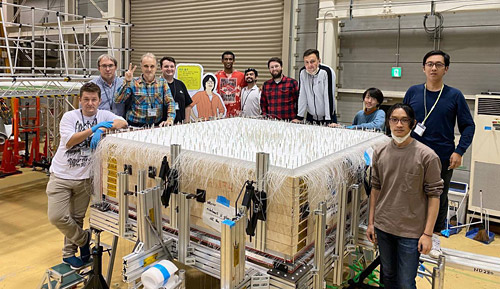
At the J-PARC research centre, the accelerator complex and the neutrino beam channel were upgraded to increase its power. The equipment for generating the neutrino beam was also significantly updated. Thanks to it, stable operation of the neutrino beam was achieved at a record high intensity (about 710 kW) that is about 40% more than before the modernization. In particular, the current supplied to the pulsed electromagnets that are used to focus charged particles into the decay channel was increased from 250 to 320 kA. It allowed to further increase the intensity of the neutrino beam by another 10%. In addition, new detectors have been installed in the ND280 near detector of the T2K experiment that allow the investigation of neutrino interactions with even greater precision than before.
New detector equipment includes:
- SuperFGD detector that is used as an active target and allows one to reconstruct tracks around the neutrino interaction point;
- High-Angle TPC time-projection chamber that measures the pulses of charged particles emitted at large angles in neutrino-nuclear interactions;
- time-of-flight detectors that can determine the direction of movement and type of particles.
The first candidate events for neutrino interactions were successfully registered during a technical session to put into operation new detectors after the start of operation of the updated neutrino beam.
It should be emphasized that the SuperFGD detector was developed and manufactured in Russia. The main organizations participating in this work were INR, JINR and Lebedev Physical Institute. A group of DLNP physicists and engineers made important contributions to the development of this new type of target for neutrino interactions. As our colleague Professor Yu.G.Kudenko (INR) noted, the registration of the first events marks the birth of a new unique neutrino detector SuperFGD.
In 2020, the T2K collaboration published the first-ever strongest constraint on the parameter that governs the breaking of symmetry between matter and antimatter in the lepton sector, including neutrino oscillations (the so-called δCP phase). Thanks to the introduction of new technologies and improvements to the T2K experiment, it will continue to be at the forefront of research in the field of deep understanding of the properties of neutrinos and unraveling the mystery of the disappearance of antimatter in the Universe. These advances will allow scientists to obtain more accurate and reliable data that in turn will improve the quality of their results and advance the boundaries of our knowledge of elementary particles and their role in developing our world.
Goal of the experiment
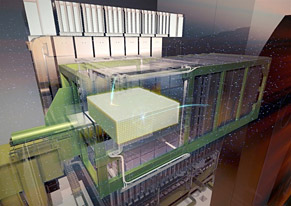 |
| New ND280 Near Detector Configuration |
For reference
(*1) Neutrino oscillations. This is a phenomenon predicted by Bruno Pontecorvo, in which neutrinos of one type periodically transform into neutrinos of another type as they move. The experimental discovery of this phenomenon at the end of the 20th century showed that neutrinos have mass. Professors Takaaki Kajita and Arthur B. McDonald were awarded the 2015 Nobel Prize in Physics for this discovery.
(*2) Violation of CP symmetry (charge-space symmetry)
The symbol C in CP symmetry denotes the "C transformation" that reverses the positions of positive and negative electrical charges and P denotes the "P transformation" that reverses the directions up-down, left-right, back-and-forth with respect to space, as if they were mirror images. When the same physical phenomenon occurs with the same probability under the C-transform and the P-transform, it is called CP symmetry. If it does not obey CP symmetry, then this is called CP symmetry violation. CP symmetry violation is one of the conditions that explains the fact that the modern Universe is dominated by matter rather than antimatter. However, the CP symmetry violation observed in the quark sector is so small that it cannot explain the asymmetry between matter and antimatter in the modern Universe. Therefore, it is expected that the possible observation of CP symmetry violation in the lepton sector will bring us closer to solving this mystery.
(*3) Phase δCP
The δCP phase is a fundamental parameter of the weak interaction between elementary particles, initially introduced to explain the violation of CP symmetry in the quark sector. The phase δCP can take values from -180 to 180 degrees. In the lepton sector, including for neutrinos, the values of the δCP phase were completely unknown until recently. The 2020 T2K experiment eliminated nearly half the range of possible δCP phase values with a 99.7% (3 sigma) confidence level.
The second phase of the experiment
The international T2K experiment that involves about 570 collaborators from 78 research institutions in 14 countries has launched the second phase of the experiment using an improved neutrino beam and an upgraded ND280 near-field magnetic detector. The neutrino beam is developed from the decays of pions and kaons that are produced during the interaction of protons with an energy of 30 GeV from the J-PARC accelerator with a carbon target. To accurately calculate the spectra and fluxes of neutrinos and antineutrinos, the T2K experiment uses precision measurements of hadron yields in proton-carbon interactions at an energy of 30 GeV, obtained with the active participation of DLNP JINR staff in the NA61/SHINE experiment at the SPS accelerator (CERN). In recent years, important work has been carried out to upgrade the J-PARC main accelerator, including the power supplies for the electromagnets, reducing the proton beam acceleration cycle time from 2.48 seconds to 1.36 seconds. Thanks to it, it was possible to significantly increase the number of protons dropped onto the target to produce a more intense neutrino beam.
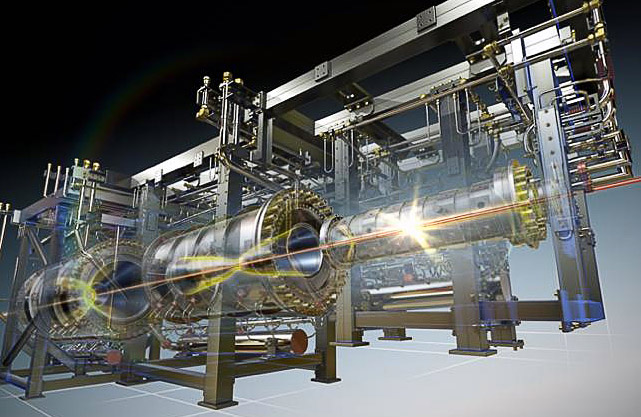
Updated equipment for producing a neutrino beam
Members of the Group of T2K beam also upgraded and replaced the neutrino beam generation equipment, including the carbon target, focusing electromagnets and beam monitors. Putting into operation the new neutrino channel configuration began in November 2023. Stable operation of the neutrino beam was successfully achieved at a record high intensity (about 710 kW) that is approximately 40% more than before the modernization. Additionally, in the focusing electromagnets (Figure), the key equipment for producing the neutrino beam, the current supplied to the three electromagnets was increased from 250 to 320 kA by upgrading the power supply and other components. It increased the efficiency of focusing parent particles, such as charged pions and kaons, produced in the target into the decay channel. As a result, the quality of the neutrino beam improved and the number of observed neutrino interactions increased by about 10%.
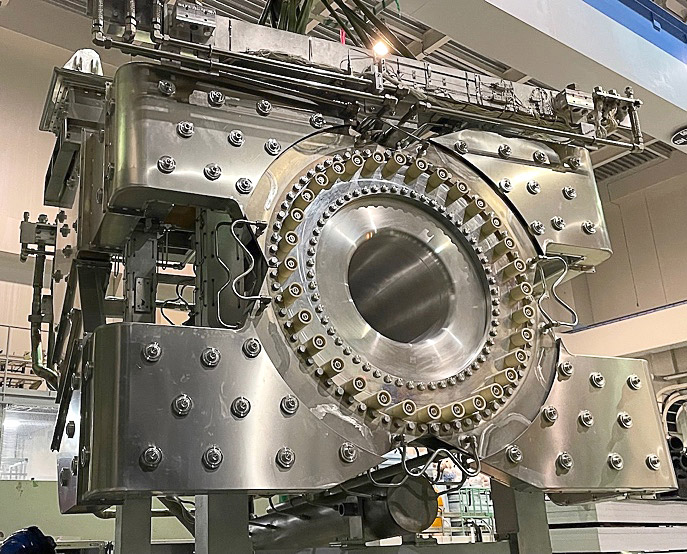
New electromagnet configuration for focusing charged particles into a decay channel with improved cooling system
to produce a more intense neutrino beam
In addition, the T2K collaboration began observations using an upgraded near detector positioned 280 m from the target. By October 2023, three new types of detectors were installed. The unique SuperFGD detector with a mass of about two tons of sensitive volume is positioned at the centre of the modernized detectors. It has an innovative structure consisting of about two million 1 cm3 plastic scintillator cubes with holes. Thanks to the use of approximately 56000 optical fibers piercing the cubes in three directions and photodetectors at the ends of the fibers, charged particles can be observed with high spatial resolution in three projections and even short tracks can be reconstructed.
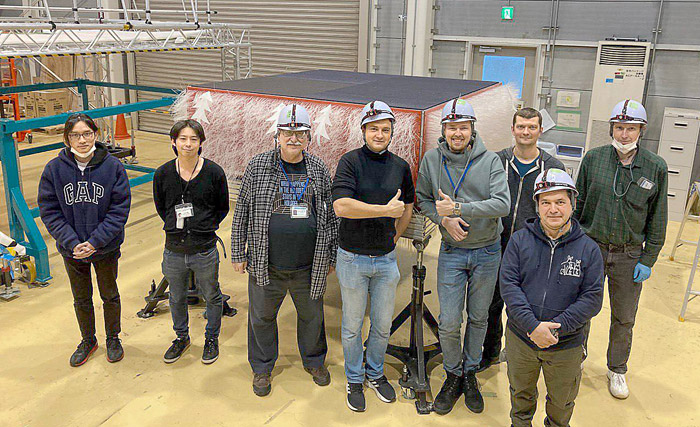
Stages of assembling the active target of the SuperFGD detector at the J-PARC Research Centre
The new HA-TPC time projection chamber allows precise measurements of the momenta of charged particles produced in neutrino interactions in SuperFGD that are emitted at large angles relative to the direction of the neutrino beam. Finally, the detectors surrounding this entire structure are time-of-flight detectors. They are used to determine the direction of movement of particles and identify them. Participants in the T2K collaboration installed all these new detectors in autumn, 2023 and immediately put them into operation. After starting data accumulation with the upgraded neutrino beam in December 2023, we were able to observe the first candidate events for neutrino interactions. The next data accumulation session at the J-PARC accelerator is scheduled for February-March 2024.
Prospects
With these improvements, the T2K experiment enters a new phase with an improved neutrino beam and new detectors. The J-PARC accelerator and neutrino experimental facility are in the process of upgrade that will ultimately increase the beam power to 1.3 MW (1300 kW). With updated neutrino beam equipment, such as electromagnets with improved focusing efficiency, it will be possible to observe about three times more neutrino interactions per unit time than before and reduce the error arising from statistical uncertainties. In addition, the new near detector will allow to study in more detail neutrino-nuclear interactions with particle production at large angles that was not possible using the previous configuration of the ND280 detector. It will allow us to better understand the properties of neutrino-nuclear interactions and therefore, to reduce systematic errors.
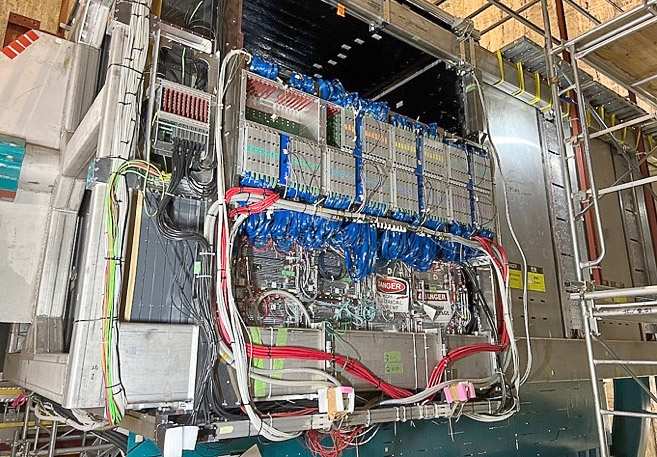
New SuperFGD and HA-TPC detectors inside the ND280 magnet
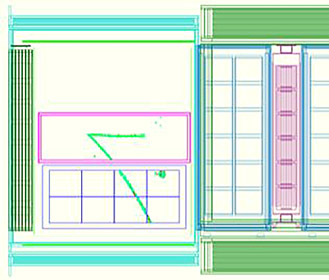 |
| The registered event is a candidate for neutrino interaction in the modernized detector |
The new phase of the T2K experiment is an important step towards the next generation of neutrino experiments, such as the Hyper-Kamiokande project [4] in Japan. The upgraded ND280 near-field detector will be one of three core components in the new Hyper-Kamiokande project: a neutrino channel, a near-field neutrino detector and a new far-field water Cherenkov detector, the effective volume of which is eight times higher than the volume of the current Super-Kamiokande detector and the construction of which has already begun. The Hyper-Kamiokande experiment is scheduled to start registering data in 2027 and is expected to continue to lead the world in neutrino physics research, bringing us closer to solving the mystery of the disappearance of antimatter in the observable universe.
Previous publications can be found in No.29 (26 July, 2013) and No. 12 (17 April, 2020) of the JINR weekly.
B.A.Popov, Yu.I.Davydov,
Participants of the T2K experiment
[1] The T2K Experiment, T2K Collaboration, K.Abe et al., Nucl.Instrum.Meth.A 659 (2011) 106-135; 1106.1238 [physics.ins-det]
[2] Observation of Electron Neutrino Appearance in a Muon Neutrino Beam, T2K Collaboration, K.Abe et al., Phys.Rev.Lett. 112 (2014) 061802; 1311.4750 [hep-ex] http://jinrmag.jinr.ru/win/2013/29/ko29.htm
[3] Constraint on the matter-antimatter symmetry-violating phase in neutrino oscillations, T2K Collaboration, K.Abe et al., Nature 580 (2020) 7803, 339-344 http://jinrmag.jinr.ru/2020/12/tk12.htm
[4] Hyper-Kamiokande Design Report, Hyper-Kamiokande Collaboration, K.Abe et al., 1805.04163 [physics.ins-det]